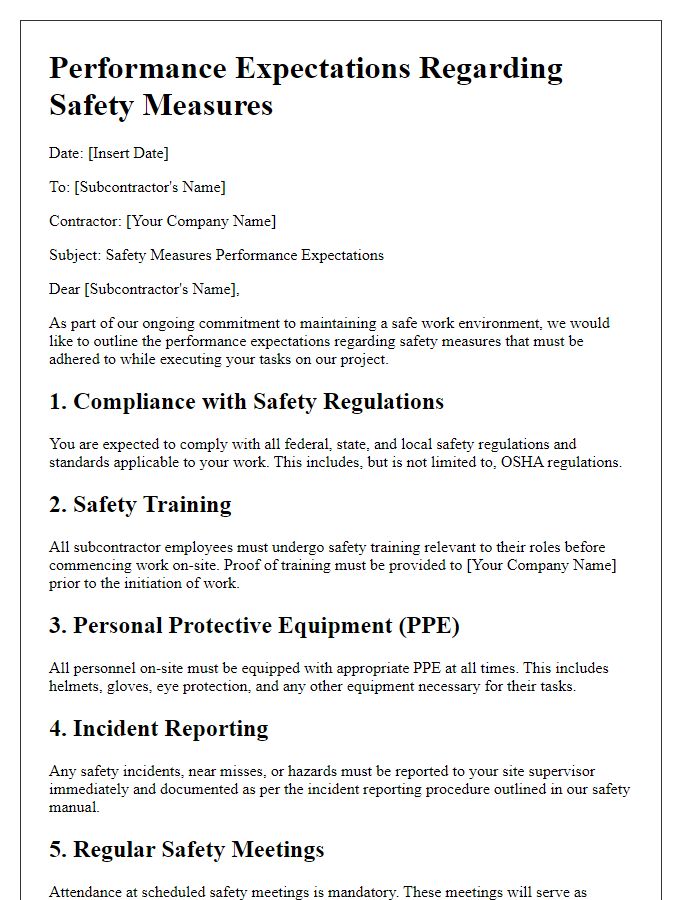When it comes to ensuring the safety and efficiency of your projects, having a clear plan for incident preventive measures is crucialâespecially when working with subcontractors. This letter template serves as a friendly reminder of the best practices we can implement together to mitigate risks and promote a culture of safety on-site. By outlining specific responsibilities and protocols, we can create a collaborative environment that prioritizes the well-being of everyone involved. Ready to dive into the nitty-gritty of incident prevention? Let's explore these preventive measures together!

Clear communication channels
Establishing clear communication channels is essential for preventing incidents in subcontractor operations within high-risk environments, such as construction sites. Effective communication protocols, including daily briefings and regular safety meetings, can ensure that all team members, including subcontracted workers, are aware of potential hazards and safety procedures. Utilizing tools such as mobile communication apps (e.g., Slack or Microsoft Teams) allows for real-time updates regarding site conditions and safety alerts. Furthermore, implementing defined reporting structures for incidents or near misses encourages prompt reporting and immediate action, thereby minimizing risks. Providing comprehensive training on communication tools and protocols enhances understanding and responsiveness among subcontractors, reducing the likelihood of misunderstandings that could lead to accidents or unsafe conditions.
Defined safety protocols
Establishing defined safety protocols for subcontractors is essential in minimizing workplace incidents on construction sites. Specific guidelines must include mandatory training sessions, such as OSHA-certified safety courses that focus on fall protection and hazard communication. Each subcontractor should be required to complete these trainings before commencing work. Regular safety audits must also be scheduled, ensuring compliance with the latest National Safety Council standards. Reporting mechanisms for near-miss incidents need to be implemented, fostering a culture of safety awareness among all personnel. Personal protective equipment (PPE), including hard hats and safety goggles, must be provided, with strict enforcement of their usage. Compliance with defined safety protocols not only protects workers but also enhances project efficiency by reducing downtime due to accidents.
Comprehensive risk assessment
A comprehensive risk assessment is essential for identifying potential hazards associated with subcontractor activities in various construction sites, such as high-rise buildings in New York City or infrastructure projects in California. This process involves systematically evaluating the likelihood of incidents, such as falls from heights or equipment malfunctions, and their potential consequences on worker safety and project timelines. Key elements include gathering data on past incidents, analyzing site-specific conditions, and establishing protocols for monitoring equipment like scaffolding and cranes. Additionally, training sessions for subcontractors on safety practices and emergency procedures must be prioritized. Regular audits, health assessments, and communication of findings to all team members will enhance awareness and adherence to safety standards, ultimately fostering a safer work environment across all project locations.
Regular training sessions
Regular training sessions are essential for subcontractors in construction projects. These sessions enhance safety awareness and operational efficiency, focusing on industry regulations such as OSHA (Occupational Safety and Health Administration) guidelines relevant to the United States. Hands-on training, scheduled quarterly, can significantly reduce the likelihood of incidents on-site, which accounted for over 4,500 workplace fatalities in 2022. Specific topics like proper equipment handling, hazard recognition, and emergency procedures are vital components. Each session can accommodate up to 30 participants, utilizing experienced trainers familiar with the unique challenges faced in construction environments. Additionally, these initiatives promote compliance with contractual obligations that require maintaining a safe working environment, ultimately improving project outcomes and fostering a culture of safety.
Continuous monitoring and evaluation
Continuous monitoring and evaluation of subcontractor performance plays a critical role in incident prevention within construction projects. Regular assessments, conducted quarterly, enable project management teams to identify potential risks and ensure compliance with safety regulations set by entities such as the Occupational Safety and Health Administration (OSHA). Utilizing real-time data analytics, project managers can monitor subcontractor adherence to safety protocols at sites like the Hudson Yards Development in New York. Additional training sessions for subcontractors, held bi-annually, reinforce best practices and highlight any emerging safety challenges. Implementing a feedback loop that includes input from subcontractor employees enhances communication and fosters a culture of safety, ultimately decreasing incident rates on job sites.
Letter Template For Subcontractor Incident Preventive Measures Samples
Letter template of incident preventive measures for subcontractors engaged in construction projects.

Letter template of safety protocol implementation for subcontractors during industrial operations.

Letter template of risk management strategies for subcontractors on-site.

Letter template of subcontractor safety compliance guidelines for project managers.

Letter template of incident reporting procedures for subcontractors in service agreements.

Letter template of preventive action plans for subcontractor teams in hazardous environments.

Letter template of subcontractor training requirements for safety and incident prevention.

Letter template of performance expectations for subcontractors regarding safety measures.

Letter template of emergency response plans for subcontractors involved in operational tasks.





Comments